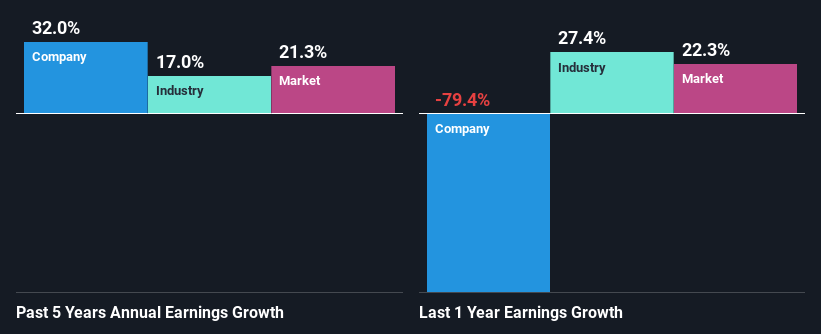Stock Analysis
Is Aspinwall and Company Limited's (NSE:ASPINWALL) Recent Stock Performance Influenced By Its Fundamentals In Any Way?

Most readers would already be aware that Aspinwall's (NSE:ASPINWALL) stock increased significantly by 14% over the past month. Given that stock prices are usually aligned with a company's financial performance in the long-term, we decided to study its financial indicators more closely to see if they had a hand to play in the recent price move. Particularly, we will be paying attention to Aspinwall's ROE today.
ROE or return on equity is a useful tool to assess how effectively a company can generate returns on the investment it received from its shareholders. Put another way, it reveals the company's success at turning shareholder investments into profits.
See our latest analysis for Aspinwall
How To Calculate Return On Equity?
The formula for ROE is:
Return on Equity = Net Profit (from continuing operations) ÷ Shareholders' Equity
So, based on the above formula, the ROE for Aspinwall is:
3.7% = ₹66m ÷ ₹1.7b (Based on the trailing twelve months to December 2023).
The 'return' is the income the business earned over the last year. Another way to think of that is that for every ₹1 worth of equity, the company was able to earn ₹0.04 in profit.
Why Is ROE Important For Earnings Growth?
So far, we've learned that ROE is a measure of a company's profitability. We now need to evaluate how much profit the company reinvests or "retains" for future growth which then gives us an idea about the growth potential of the company. Assuming everything else remains unchanged, the higher the ROE and profit retention, the higher the growth rate of a company compared to companies that don't necessarily bear these characteristics.
Aspinwall's Earnings Growth And 3.7% ROE
As you can see, Aspinwall's ROE looks pretty weak. Even when compared to the industry average of 12%, the ROE figure is pretty disappointing. However, we we're pleasantly surprised to see that Aspinwall grew its net income at a significant rate of 32% in the last five years. We believe that there might be other aspects that are positively influencing the company's earnings growth. Such as - high earnings retention or an efficient management in place.
Next, on comparing with the industry net income growth, we found that Aspinwall's growth is quite high when compared to the industry average growth of 17% in the same period, which is great to see.

Earnings growth is an important metric to consider when valuing a stock. It’s important for an investor to know whether the market has priced in the company's expected earnings growth (or decline). This then helps them determine if the stock is placed for a bright or bleak future. Is Aspinwall fairly valued compared to other companies? These 3 valuation measures might help you decide.
Is Aspinwall Using Its Retained Earnings Effectively?
Aspinwall has a really low three-year median payout ratio of 24%, meaning that it has the remaining 76% left over to reinvest into its business. So it seems like the management is reinvesting profits heavily to grow its business and this reflects in its earnings growth number.
Additionally, Aspinwall has paid dividends over a period of seven years which means that the company is pretty serious about sharing its profits with shareholders.
Summary
On the whole, we do feel that Aspinwall has some positive attributes. Even in spite of the low rate of return, the company has posted impressive earnings growth as a result of reinvesting heavily into its business. While we won't completely dismiss the company, what we would do, is try to ascertain how risky the business is to make a more informed decision around the company. To know the 5 risks we have identified for Aspinwall visit our risks dashboard for free.
Valuation is complex, but we're helping make it simple.
Find out whether Aspinwall is potentially over or undervalued by checking out our comprehensive analysis, which includes fair value estimates, risks and warnings, dividends, insider transactions and financial health.
View the Free AnalysisHave feedback on this article? Concerned about the content? Get in touch with us directly. Alternatively, email editorial-team (at) simplywallst.com.
This article by Simply Wall St is general in nature. We provide commentary based on historical data and analyst forecasts only using an unbiased methodology and our articles are not intended to be financial advice. It does not constitute a recommendation to buy or sell any stock, and does not take account of your objectives, or your financial situation. We aim to bring you long-term focused analysis driven by fundamental data. Note that our analysis may not factor in the latest price-sensitive company announcements or qualitative material. Simply Wall St has no position in any stocks mentioned.
About NSEI:ASPINWALL
Aspinwall
Aspinwall and Company Limited, a multi-line business organization, engages in coffee processing and trading, rubber plantation, natural fiber, and shipping and logistics businesses in India, the Americas, Europe, and internationally.
Adequate balance sheet second-rate dividend payer.

